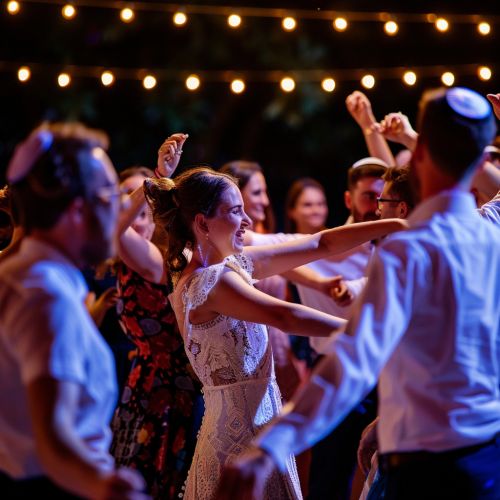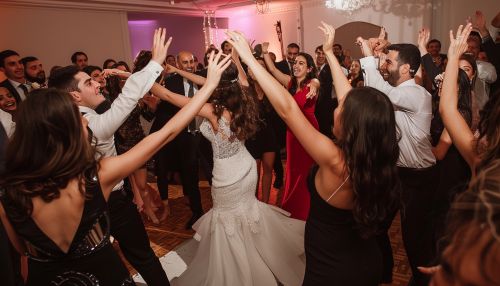Hora: Difference between revisions
(Created page with "== Etymology and Definition == The term "Hora" has its roots in the Greek word "ὥρα" (hōra), which means "hour" or "season." In various cultures, the word has been adapted to refer to different concepts, most notably in dance and timekeeping. The Hora is a traditional dance in many Eastern European countries, particularly among Jewish communities, and it also signifies a unit of time in ancient Greek and Roman cultures. == Historical Background == === Ancient Gre...") |
No edit summary |
||
| Line 23: | Line 23: | ||
Different regions have their own variations of the Hora. In Romania, the dance is known as "Hora Mare" and is often accompanied by traditional folk music. In Bulgaria, it is called "Horo" and includes more complex footwork and faster tempos. The Jewish Hora, often performed to the song "Hava Nagila," is perhaps the most internationally recognized version. | Different regions have their own variations of the Hora. In Romania, the dance is known as "Hora Mare" and is often accompanied by traditional folk music. In Bulgaria, it is called "Horo" and includes more complex footwork and faster tempos. The Jewish Hora, often performed to the song "Hava Nagila," is perhaps the most internationally recognized version. | ||
[[Image:Detail-91997.jpg|thumb|center|A group of people performing the Hora dance at a wedding celebration.|class=only_on_mobile]] | |||
[[Image:Detail-91998.jpg|thumb|center|A group of people performing the Hora dance at a wedding celebration.|class=only_on_desktop]] | |||
== Cultural Significance == | == Cultural Significance == | ||
Latest revision as of 16:41, 18 June 2024
Etymology and Definition
The term "Hora" has its roots in the Greek word "ὥρα" (hōra), which means "hour" or "season." In various cultures, the word has been adapted to refer to different concepts, most notably in dance and timekeeping. The Hora is a traditional dance in many Eastern European countries, particularly among Jewish communities, and it also signifies a unit of time in ancient Greek and Roman cultures.
Historical Background
Ancient Greece and Rome
In ancient Greece, the Horae were goddesses of the seasons and natural order. They were originally three in number: Thallo (Spring), Auxo (Summer), and Carpo (Autumn). The concept of Horae later expanded to include the hours of the day, each governed by a specific deity. In Roman culture, the Horae were similarly revered and were often depicted in art and literature.
Eastern European Tradition
The Hora dance is a circle dance originating from the Balkans but is most commonly associated with Romanian, Bulgarian, and Jewish cultures. The dance is performed in a circle, symbolizing unity and continuity. It is traditionally performed at weddings, festivals, and other communal celebrations.
The Hora Dance
Structure and Movements
The Hora dance is characterized by its simple, repetitive steps, which make it accessible to dancers of all skill levels. The basic steps involve a sequence of side steps, forward and backward movements, and occasional jumps. The dancers hold hands or link arms, forming a circle that moves clockwise or counterclockwise.
Variations by Region
Different regions have their own variations of the Hora. In Romania, the dance is known as "Hora Mare" and is often accompanied by traditional folk music. In Bulgaria, it is called "Horo" and includes more complex footwork and faster tempos. The Jewish Hora, often performed to the song "Hava Nagila," is perhaps the most internationally recognized version.


Cultural Significance
Symbolism
The circular formation of the Hora dance symbolizes unity, eternity, and the cyclical nature of life. It is often performed at significant life events such as weddings, where it represents the joining of two families and the start of a new life cycle.
Social Function
The Hora serves as a social glue, bringing communities together and reinforcing cultural identity. It is a communal activity that encourages participation from all members, regardless of age or skill level. The dance also serves as a medium for passing down traditions and cultural values from one generation to the next.
Musical Accompaniment
The music accompanying the Hora dance varies by region but generally features lively, rhythmic tunes played on traditional instruments. In Romania, instruments like the violin, accordion, and cimbalom are commonly used. In Jewish traditions, the clarinet and fiddle are prominent, often accompanied by a full klezmer band.
Modern Adaptations
Contemporary Performances
In modern times, the Hora has been adapted to various contemporary settings. It is often performed at international folk dance festivals, cultural exhibitions, and even in popular media. The dance has also been incorporated into modern choreographies, blending traditional steps with contemporary dance styles.
Educational Programs
Many cultural organizations and schools offer programs to teach the Hora dance, aiming to preserve this important cultural heritage. These programs often include lessons on the history and significance of the dance, as well as practical instruction on the steps and movements.
